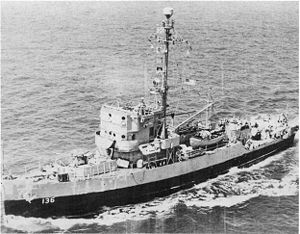Admirable class minesweeper

USS Admirable (AM-136) underway, ca. 1944.
|
|
| Class overview | |
|---|---|
| Operators: | |
| Preceded by: | Hawk-class minesweeper |
| Succeeded by: | Agile-class minesweeper |
| Planned: | 147 |
| Completed: | 123 |
| Cancelled: | 24 |
| Preserved: | 1 |
| General characteristics | |
| Displacement: | 625 tons |
| Length: | 184 ft 6 in (56.24 m) |
| Beam: | 33 ft (10 m) |
| Draft: | 10 ft (3.0 m) |
| Speed: | 15 knots (27.8 km/h) |
| Complement: | 104 officers and men |
| Armament: |
|
The Admirable class was the largest and one of the most successful classes of minesweepers the United States Navy ordered during World War II. Typically, the minesweeper detected and removed naval mines before the rest of the fleet arrived, thereby ensuring safe passage for the larger ships. They were also charged with anti-submarine warfare (ASW) duties with rear-mounted depth charge racks and a forward-firing Hedgehog antisubmarine mortar. Their job was essential to the safety and success of U.S. naval operations during World War II and the Korean War. These minesweepers were also employed as patrol vessel and convoy escorts.
As a part of Project Hula – a secret 1945 program that transferred 149 U.S. Navy ships to the Soviet Navy at Cold Bay, Territory of Alaska, in anticipation of the Soviet Union joining the war against Japan – the U.S. Navy transferred 24 Admirable-class minesweepers to the Soviet Navy between May and August 1945. At least some of them saw action in the Soviet offensive against Japanese forces in Northeast Asia in August 1945. The Soviet Union never returned them to the United States.
After World War II, the United States transferred Admirable-class minesweepers to the Republic of China Navy, the Republic of China's Chinese Maritime Customs Service, the Republic of Korea Navy, the Republic of Vietnam Navy, and the Dominican, Mexican, Myanmar, and Philippine navies.
...
Wikipedia
